Guide H-110
Revised by John Allen
College of Agricultural, Consumer and Environmental Sciences, New Mexico State University
Author: County Program Director, Hidalgo County Extension Office, New Mexico State University. (Print friendly PDF)
Introduction
Yard waste makes up 20–30 percent of the solid waste of most municipalities throughout the United States, while food waste makes up another 8–9 percent. The cost of collecting, hauling and handling yard waste is often a large part of the budget associated with many municipal solid waste management programs, averaging 20 percent of the budget and increasing to as much as 50 percent when grass clippings and leaves are handled.
Yard and food wastes are also major factors in the production of methane gas and acid-liquid drainage in land fills. Incinerating yard wastes is a major source of air pollution. Although municipal composting is an environmentally preferable alternative for handling yard and food wastes, processing these wastes at the source reduces the major costs of collecting and has a positive effect on the environment. Backyard composting is one of the easiest ways to process yard wastes at the source.
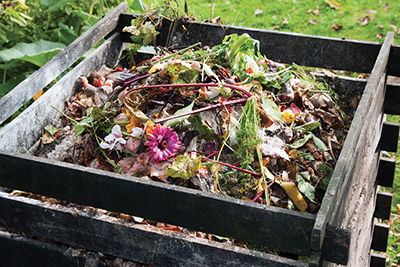
Compost bin in the garden. (© Airborne 77 | Dreamstime.com)
What is Composting?
Making compost is a sped-up way of imitating nature’s cycle of life and death. The end product in the composting process is a dark, loose, partially decomposed form of organic matter that reveals no hint of its origin. The only difference between finished compost and forest humus created by nature is time.
The actions of various microorganisms and invertebrates convert raw organic matter in a compost pile into finished compost. Maximum decomposition occurs when these organisms are exposed to an appropriate balance of oxygen, moisture, and nutrients. Products of the composting process include finished compost, carbon dioxide, heat, and water.
Aerobic and Anaerobic Composting
Composting can occur under either aerobic (in the presence of oxygen) or anaerobic (without oxygen) conditions. Microorganisms for aerobic composting require oxygen (greater than 5 percent within the compost pile), while anaerobic microorganisms prefer an absence of oxygen. Anaerobic decomposition in backyard compost piles is generally undesirable due to objectionable odors that result. The most offensive gas resulting from the anaerobic process is hydrogen sulfide (rotten egg smell), while other offensive odors include cadvarine and putrescine.
Aerobic decomposition is the preferred composting technique in most backyard composting piles because it smells better and is more efficient. Aerobic composting generates heat up to 140°F or higher, which is hot enough to kill most plant pathogens and weed seeds in the pile when properly managed.
Composting Alternatives
Sheet composting in the garden involves applying raw composting materials directly on top of the soil in layers. Shredded organic matter can be applied between plants as a type of mulch and allowed to decompose slowly. Material can then be incorporated directly into the soil after frost in the fall.
Trench composting involves digging a trench and filling it up with shredded organic waste. The trench is then covered with 6–8 inches of soil. Depending on soil temperature, microorganisms and earthworms will slowly convert these materials to usable organic matter. Covered trenches often are used as paths between rows of vegetables, while the organic matter is decomposing.
“Com-posthole-ing” is similar to trench composting except that it involves smaller areas. A posthole digger or sharpshooter can be used to make holes between plants like tomatoes, and these holes can be filled with food scraps and covered with soil. By the following spring, organic matter should be well decomposed.
The Composting Process
Compost Organisms
Most composting organisms fall into two general groups: microorganisms and invertebrates. Among the microorganisms, aerobic bacteria are the most important in terms of initiating decomposition and heat generation.
Bacteria are one-celled organisms that cannot make their own food through photosynthesis. They reproduce by splitting, producing billions of offspring over a relatively short time, although the life span of any particular generation may be only 20–30 minutes. As a group, they can eat almost any type of organic matter, although specific bacterial populations will differ from pile to pile depending on the makeup of the pile and the decomposition stage.
Psychrophilic bacteria are active when a pile is first made, especially in the fall when the weather is cool. Optimal activity occurs at about 55°F, but these bacteria are still active at 0°F. The bacterial activity creates heat and sets the stage for the most efficient decomposers, the mesophilic bacteria, which are most active when the temperature of the pile is at 70–100°F.
Rapid decomposition of the pile by mesophilic bacteria creates heat. As the temperature of the pile increases, thermophilic bacteria take over from 113–155°F and higher. Most weed seeds and organisms causing plant diseases are killed at these temperatures. Unless turned and fed new material, thermophilic bacteria will decompose material rapidly, peaking in 2–3 days. The pile will then return to the lower temperature range where mesophilic bacteria are active.
Other important microorganisms in the composting process include actinomycetes and fungi. Similar to bacteria and fungi, actinomycetes give the compost pile its faintly earthy odor. At the end of the composting process, they may appear as a blue-gray to light green powdery or cobweb-like layer in the outer 4–6 inches of compost. Fungi generally intermingle with the actinomycetes.
When the inner pile starts to heat up, most invertebrates are killed or migrate to cooler areas of the pile. In the cooler areas, nematodes prey upon bacteria, protozoa, and fungal spores. Larger mites and springtails also feed on fungi. The life cycle within the pile continues to become more complex as predaceous mites and pseudoscorpions feed on other mites as well as nematodes. Complex invertebrates like centipedes and ground beetles feed on lower life forms, and decaying plant life in the pile attracts sowbugs, snails, slugs, and earthworms.
Carbon:Nitrogen Balance
A compost pile that heats up properly and decomposes rapidly depends on a number of environmental factors within the pile. One of the most critical factors is the balance of carbon and nitrogen within the plant and animal wastes added to the pile.
Although a number of nutrient ratios—such as nitrogen to phosphorous—are important in the composting process, the most critical is the carbon:nitrogen ratio, commonly expressed as “C:N” or “C/N.” Microorganisms need carbon for energy and nitrogen for protein synthesis. Decomposition within the compost pile is optimal when the C:N ratio is about 30:1. Excess nitrogen in the pile results in the production of ammonia when there is not enough carbon in the pile for microorganisms to synthesize new cellular material. When there is not enough nitrogen to produce proteins for microorganism growth, the composting process slows.
While most organic materials in the pile vary in their carbon:nitrogen ratios, they must be balanced to produce the ideal of 30:1. Most dry or woody materials are high in carbon, while green wastes or livestock manures are relatively low (Table 1). Because plant materials vary in C:N ratios due to water content and growth stage, tables of C:N ratios can be used only as guides in mixing materials. Thus, composting is as much an art as it is a science.
|
Table 1. Carbon:Nitrogen Ratios for Selected Organic Wastes (by weight) |
|
|
Material |
C:N Ratio |
|
Low C:N materials |
|
|
Grass clippings |
12–15:1 |
|
Food scraps |
15:1 |
|
Vegetable wastes |
11–20:1 |
|
Coffee grounds |
20:1 |
|
Cow manure |
18–20:1 |
|
Horse manure |
25:1 |
|
Poultry manure |
15:1 |
|
High C:N materials |
|
|
Leaves |
30–80:1 |
|
Straw |
40–100:1 |
|
Corn stalks |
60:1 |
|
Paper |
170–200:1 |
|
Sawdust |
200–500:1 |
Surface Area Effects
Decomposition within the pile can be aided by increasing the surface area of organic material added to the pile. Because microbial activity occurs mostly on the surface of waste added to the pile, increasing the surface area will increase the number of microorganisms working on the material.
One of the most efficient ways to increase the surface area of organic waste is to run it through a mechanical shredder or chipper. Shredders and chippers can be large or small, run by electricity, gas, or by hand. Fall leaves can be run through a rotary mower. Loppers and hand shears can be used to reduce the size of hedge trimmings or branches.
Aeration
Turning the compost pile periodically is critical for aerobic composting since much of the air available to microorganisms within the pile comes from air trapped in it when the pile is turned. The more often the pile is turned, the more air enters it. Some fresh air enters the pile from wind, while air also can be drawn into the pile naturally as warm air from the composting process rises.
Aeration also depends on the amount of water in the pile and the porosity (size of spaces between particles in the pile) of the pile’s contents. These spaces can hold both water and air. Thus, as water contact increases, possibilities for air contact decrease. Mixing coarse, dry materials like autumn leaves with wet, green materials like grass trimmings will increase the airflow throughout the pile.
In backyard composting projects, a garden fork or pitchfork is one of the best tools to turn or fluff up a pile. Compost piles can also be constructed so that they “breathe” on one or more sides.
Moisture Content
For optimal aerobic composting, moisture content of the pile should range between 40 and 60 percent. A higher percentage will increase anaerobic decomposition, while a lower moisture content will slow down the composting process as microorganisms die or become dormant.
Squeeze compost in your hand to judge moisture content. If the material feels like a damp sponge and yields only a few drops when squeezed tightly, its moisture content is sufficient. Piles that are too wet should be turned to increase air content; piles that are too dry should be turned and sprinkled with a hose.
Building a Compost Pile
Most compost piles aren’t aesthetic masterpieces, so locating them in an inconspicuous but convenient location is appropriate. Be sure a source of water is nearby. Locating the pile in a shaded area will keep it from drying out. Since most compost is used in the garden, easy access to this area is essential.
Minimum dimensions for a pile are 3 × 3 × 3 ft since smaller piles will not heat up or decompose. The pile should be large enough to hold the heat that it generates, yet small enough to allow air movement into the center of the pile. Piles taller than 5 ft are difficult to turn and may restrict air flow due to weight. The length of the pile depends on the amount of material to be composted.
Gardeners with large amounts of yard waste should consider constructing two or more compost piles or bins. Two bins are convenient when turning the material, while multiple bins initiated at different times provide for compost at different stages of decomposition.
Compost Structures
Your choice of a composting structure depends on your time requirements for finished compost, space limitations, and budget restraints. Making finished compost quickly requires that the structure be adapted to turning the compost frequently. Gardeners who are especially conscious of aesthetics may prefer rotating barrel composters (Figure 1). Though relatively expensive, these structures are less messy and produce finished compost more quickly than other structures since they can be turned easily. Fins inside the barrel keep material well aerated (Figure 2).
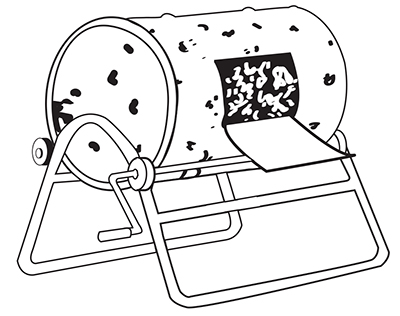
Figure 1. Rotating barrel composter.
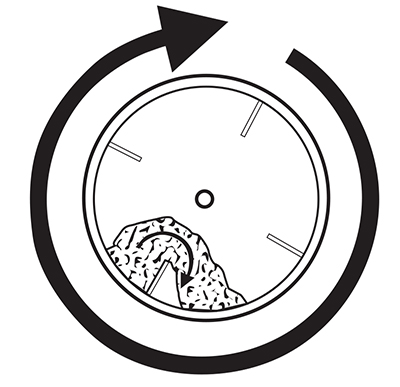
Figure 2. Fin structure in barrel composter.
Another relatively expensive structure is the three-bin composting unit. These bins can be made of sliding redwood slats (Figure 3), a combination of redwood slats and hardware cloth (Figure 4), or cement blocks (Figure 5). The hardware cloth structures tend to be better aerated, and compost can be easily transferred from one bin to another.
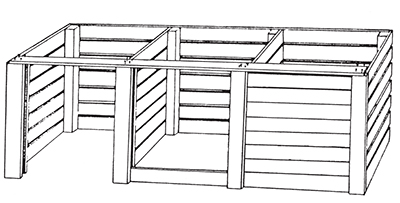
Figure 3. Redwood slat three-bin composting unit.
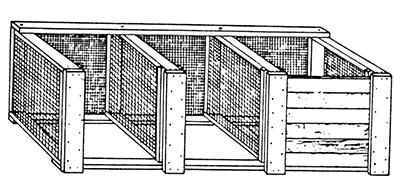
Figure 4. Redwood slat hardware screen three-bin composting unit.
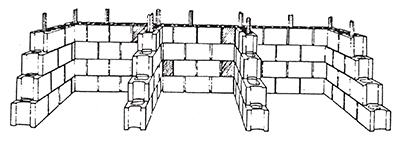
Figure 5. Cement block three-bin composting unit.
Heap composting is the cheapest method of composting, but it tends to take up more room and is somewhat messier. Finished compost can be generated quickly if at least two heaps are maintained for turning purposes.
“Holding” compost units tend to be slower in terms of creating finished compost because they tend to be turned less frequently, if at all. Materials are generally added to the holding unit as they are generated. To keep pest problems to a minimum, incorporate food wastes into the middle of other yard wastes. Holding units can be composed of redwood slats (Figure 6), wire fencing or chicken wire (Figure 7), snow fence (Figure 8), or cement blocks (Figure 9). All these structures may require steel or redwood corner posts for support.
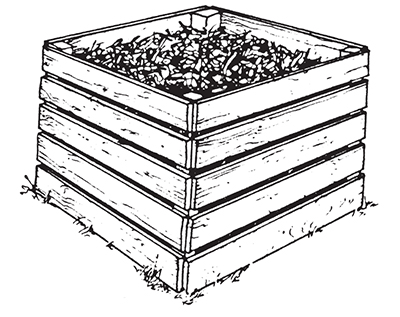
Figure 6. Redwood slat holding unit.
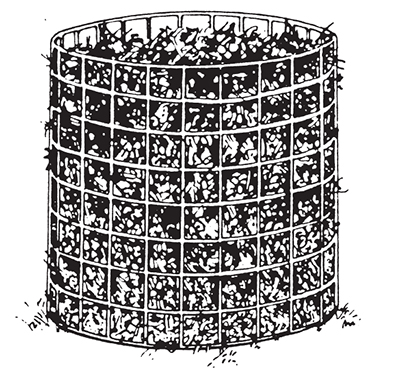
Figure 7. Wire fence holding unit.
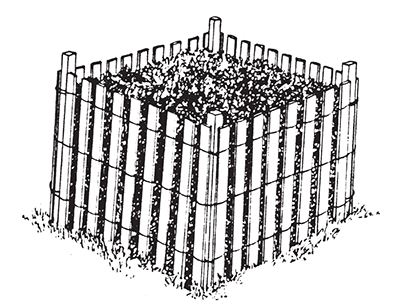
Figure 8. Snow fence holding unit.
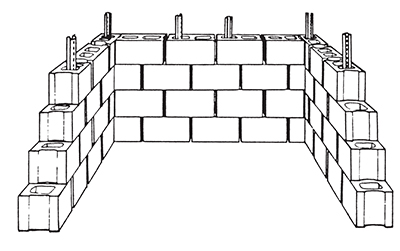
Figure 9. Cement block holding unit.
Composting Techniques
The most popular composting technique involves alternating layers of organic materials, soil, and fertilizer or manure (Figure 10). Layers can be laid down in either specially constructed bins or piles.
A 6- to 8-inch layer of coarse organic material, such as shredded corn cobs or sawdust, is put down first to provide aeration from the bottom. This material will also help absorb leachate that trickles down through the pile.
Sprinkle a thin layer of fertilizer (1 cup of 12-12-12 or equivalent per 25 square ft of surface rea) over the layer of organic material. Fertilizers provide nitrogen necessary to reduce the high carbon:nitrogen ratios associated with coarse materials like corncobs and sawdust. Use a complete fertilizer to keep phosphorous and potassium in balance with the nitrogen.
A 1- to 2-inch layer of poultry, rabbit or livestock manure can be substituted for the fertilizer. Horse manure mixed with bedding materials is an excellent source of nitrogen and microorganisms that start the composting process. A layer of soil will also introduce microorganisms into the pile.
Wet grass clippings also can be mixed with drier, coarser materials for a source of nitrogen. Be careful not to layer wet grass clippings in the pile since they tend to mat, and matted wet clippings become sticky masses of slime through anaerobic decomposition, restricting air and water movement in the pile.
Continue to layer organic materials with fertilizer or manure and soil until the pile is 3–5 ft high. Be sure to moisten each layer with water as it is laid down. This is particularly important for drier, coarser materials.
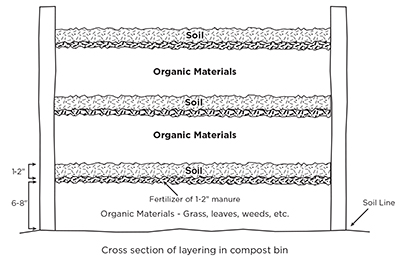
Figure 10. Layering technique for compost pile or bin.
Composting Materials
Almost all plant materials can be used in a compost pile. Do not place diseased plants and weed seeds in a compost pile, however, because the pile construction may not be optimal for proper heating. In addition, do not put sprigs of perennial lawn grasses like Bermudagrass and root systems of perennial weeds like Johnsongrass and bindweed into your compost pile.
Whenever possible, select plant materials for composting that will balance high C:N ratio materials with low C:N ratio materials. Compost piles made of mostly high C:N ratio materials may require extra nitrogen fertilizer or livestock manure to reduce the average C:N ratio for the pile. Animal manures that should not be used include pet (cat and dog) and pig manures that may contain disease organisms that can infect humans. Avoid fatty food wastes like meat and bones because the odors they generate attract pests. Avoid wood ashes because they tend to be very alkaline. Table 2 lists plant and animal wastes to include in the compost pile and those to avoid.
|
Table 2. Compost Pile Wastes to Include or Exclude |
|
|
Include |
Exclude |
|
Leaves |
Weeds (perennials) |
|
Sawdust |
Diseased plants |
|
Grass clippings (except Bermudagrass) |
Pig manure |
|
Weeds (annual) |
Pet manure (cat and dog) |
|
Vegetable wastes |
Meat |
|
Fruit wastes |
Fat |
|
Straw |
Oils and lards |
|
Tree and brush trimmings (shredded) |
Milk and cheese products |
|
Paper |
|
|
Egg shells |
|
|
Coffee grounds |
|
|
Chicken manure |
|
|
Rabbit manure |
|
|
Livestock manure (except pig) |
|
Maintaining a Compost Pile
Proper, uniform moisture levels for optimal microbial activity can best be maintained by turning the pile. Soggy piles will revert to anaerobic decomposition and need to be fluffed up. Aerobic microbial activity slows in dry piles; thus, when turning dry piles, moisten the compost.
Generally, the more compost is turned the faster it decomposes. While frequently turned piles can yield finished compost in as little as 14 days, piles turned less frequently may take as long as a year to produce finished compost. The time required to develop finished compost also depends on the size of the pile and time of year or air temperature.
When turning, move compost from the outside edges of the pile or bin to the middle of the new pile so that it can heat up in the composting process. The finished compost pile should be half the size of the original pile. Most of the size loss is associated with the production of carbon dioxide in the composting process.
Troubleshooting
The compost pile may fail to heat up and decompose properly for a number of reasons. Consult Table 3 for common symptoms, problems, and solutions.
|
Table 3. Troubleshooting Composting Problems |
|
|
Symptom/Problem |
Solution |
|
Rotten egg smell |
|
|
Insufficient air; excess moisture |
Turn pile and incorporate coarse organic matter (sawdust, leaves) |
|
Ammonia smell |
|
|
Organic material too high in nitrogen |
Add coarse organic material (sawdust, leaves) |
|
Pile does not heat up |
|
|
Pile too small |
Add more organic matter |
|
Insufficient moisture |
Turn pile and add water |
|
Lack of nitrogen |
Incorporate manure, fertilizer, or low C:N ratio plant material (lawn clippings) |
|
Poor aeration |
Turn pile |
|
Cold weather |
Increase pile size or insulate with straw |
Vermicompost
Earthworms are some of the largest organisms found in compost. Tunneling through garden soil, garden earthworms can consume as much as their own body weight in soil each day. Castings they leave behind are five to 11 times richer in nitrogen, phosphorous, and potassium than the soil they eat.
The garden earthworm and the compost earthworm, however, are radically different. Although garden or field earthworms (Allolobophora caliginosa) will penetrate the bottom of a compost pile, they prefer regular soil and will not tolerate active compost with warmer temperatures. Red worms or red wigglers (Lumbricus rubellus) and brandling worms (Eisenia fetida), however, prefer cooler compost or manure piles and will die off if the compost is too hot.
Specialized bins or boxes (Figure 11) can accommodate worm compost or vermicompost. Red worms and brandling worms prefer temperatures of 50–70°F. Shallow, ventilated wooden boxes with lids are first filled with moist bedding (50–75 percent water, by weight) made of peat moss, sawdust, or shredded newspaper. Worms are then added and allowed to crawl down through the bedding. Pockets of food waste can be buried in the bedding, and if the bed is kept moist, the worms will eventually turn the food wastes and bedding into a high-quality soil amendment. For more information, see NMSU Extension Guide H-164, Vermicomposting (https://pubs.nmsu.edu/_h/H164.pdf).
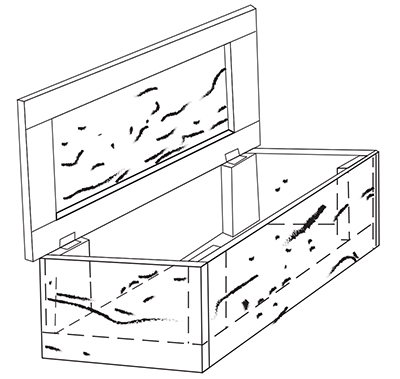
Figure 11. Worm compost box.
Compost Value and Uses
Finished compost has many uses in the home garden. Because it is created from a mixture of plant and animal wastes, it contains a broad base of both macro and micro fertilizer nutrients. Most of these nutrients are bound in an organic form and are made available to plants slowly throughout the growing season.
The relative quantity of any one nutrient found in compost is quite low; thus, the major benefit of compost lies in its soil conditioning qualities. As a rich source of organic matter, it improves the water-holding capacity of sandy soils and their ability to retain nutrients and release them to plant roots as needed.
In heavier clay soils, compost binds clay particles together to form aggregates, improving both water drainage and the ability of plant roots to penetrate the soil. Conditioning soil surface layers with compost also will improve water penetration and decrease soil erosion and soil crusting.
As a soil conditioner, compost contributes organic acids that weather mineral portions of the soil, making nutrients more available for plant uptake. Compost also improves the buffering capacity of the soil, helping stabilize soil pH levels. Because earthworms are attracted to organic matter, earthworm populations increase and make more nutrients available from deeper in the soil.
Compost is most frequently applied to garden soils in the spring before planting. Compost should be liberally applied and turned under to a depth of 4–6 in. Gardeners with limited compost should incorporate it only below the seed row. Handfuls of compost also can be incorporated in planting holes for transplants.
Compost makes an excellent top dressing for lawns, trees, shrubs and perennial flowers. Mulches around vegetables and other plants help reduce water evaporation from the soil, cut down on annual weed growth, and serve as a slow-release source of nutrients. Compost will also cool the soil and buffer soil water fluctuations.
Acknowledgments
Dickson, N., T. Richard, and R. Kozlowski. 1991. Composting to reduce the waste stream [NEAES-43]. Ithaca, NY: Northeast Regional Agricultural Engineering Service.
For Further Reading
Circular 687: Managing Organic Matter in Farm and Garden Soils
https://pubs.nmsu.edu/_circulars/CR687/
H-110: Determining Amounts of Fertilizer for Small Areas
https://pubs.nmsu.edu/_h/H119/
H-164: Vermicomposting
https://pubs.nmsu.edu/_h/H164/
All Horticulture Publication Listing
https://pubs.nmsu.edu/_h/
|
Original author: George W. Dickerson, Extension Horticulture Specialist. |

John Allen is a County Extension Agent at New Mexico State University. He earned his B.S and M.A in agriculture and Extension education at NMSU. He specializes in 4-H youth development and working with diverse audiences, and strives to bring research-based knowledge and best agricultural practices to New Mexicans to help them be successful farmers, ranchers, backyard gardeners, and productive citizens.
To find more resources for your business, home, or family, visit the College of Agricultural, Consumer and Environmental Sciences on the World Wide Web at pubs.nmsu.edu
Contents of publications may be freely reproduced for educational purposes. All other rights reserved. For permission to use publications for other purposes, contact pubs@nmsu.edu or the authors listed on the publication.
New Mexico State University is an equal opportunity/affirmative action employer and educator. NMSU and the U.S. Department of Agriculture cooperating.
Revised August 2016


